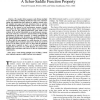Free Online Productivity Tools
i2Speak
i2Symbol
i2OCR
iTex2Img
iWeb2Print
iWeb2Shot
i2Type
iPdf2Split
iPdf2Merge
i2Bopomofo
i2Arabic
i2Style
i2Image
i2PDF
iLatex2Rtf
Sci2ools
121
click to vote
TIT
2002
2002
Optimal sequences for CDMA under colored noise: A Schur-saddle function property
We consider direct sequence code division multiple access (DS-CDMA), modeling interference from users communicating with neighboring base stations by additive colored noise. We consider two types of receiver structures: first we consider the information-theoretically optimal receiver and use the sum capacity of the channel as our performance measure. Second, we consider the linear minimum mean square error (LMMSE) receiver and use the signal-to-interference ratio (SIR) of the estimate of the symbol transmitted as our performance measure. Our main result is a constructive characterization of the possible performance in both these scenarios. A central contribution of this characterization is the derivation of a qualitative feature of the optimal performance measure in both the scenarios studied. We show that the sum capacity is a saddle function: it is convex in the additive noise covariances and concave in the user received powers. In the linear receiver case, we show that the minimum a...
| Added | 23 Dec 2010 |
| Updated | 23 Dec 2010 |
| Type | Journal |
| Year | 2002 |
| Where | TIT |
| Authors | Pramod Viswanath, Venkat Anantharam |
Comments (0)

